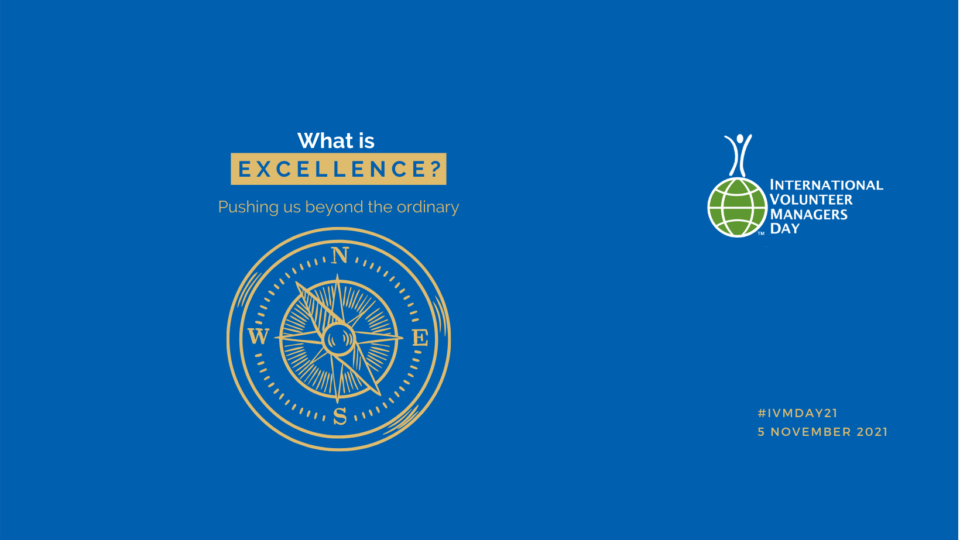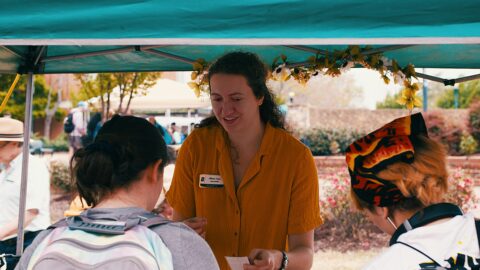by Ruth Leonard
The theme of International Volunteer Managers (IVM) Day 2021 is ‘what is excellence – pushing us beyond the ordinary’ and for me this means moving us beyond the traditionally accepted view of volunteering and therefore volunteer management.
This has become more relevant with the original response to the pandemic, such as strikingly with Mutual Aid Groups seemingly springing up across the UK in response to the needs of shielded communities. There is also increased recognition that social activism and citizen participation are forms of volunteering. So, it is timely to consider how we can factor these aspects of motivations into the infrastructure of volunteer management.
As a someone who has been involved in volunteer management for over two decades this has always been obvious – the desire of someone to help another is very powerful. What we do see when disasters or crises strike – such as the current pandemic – is people getting on and just doing; self-organising and offering support to each other.
“Never doubt that a small group of thoughtful, committed citizens can change the world; indeed, it’s the only thing that ever has” said the anthropologist Margaret Mead. I love this quote – However evidence on collective efficacy has shown that without the appropriate infrastructure and support to co-ordinate efforts and offers of help, community action can dissipate rather than proliferate.
This is important when we think about volunteering from a volunteer management perspective – there needs to be some infrastructure. This needs to be flexible enough to not get in the way of the self-organising and led aspect – to (as the Relationship Project puts it) not crush the butterfly within the jam jar – that is not lose the wonder and intrinsic value of a gift of time freely given, by trying to over-formalise it.
And I think that this is the path which volunteer management tries to straddle – the formality of a structure which supports and enables volunteering – with the informality of allowing people to use their own assets to fix what is needed within their own lives and communities.
I suspect that we are culturally used to viewing people giving their time through one lens; what we might think of as ‘traditional volunteering’, generally limited to pre-determined functions and selected for specific tasks; but to do so would mean that we are moving away from people’s motivations and interests and merely valuing the transactional and that which is carried out through an organisation – which I think is a barrier to those people who come forward because they want to just do something.
There is a wide spectrum of reasons for giving time, energy and experience and people do so in many ways – including to a variety of sectors as well as to none. For example, as well as for the more traditional charity, people volunteer with the statutory sector such as NHS, schools and prisons and also as individuals informally or within a whole host of small community groups. Also, people who give their time do not necessarily want to do so for just one entity and expect a fluidity between volunteering opportunities.
It is important that each sector shares its assets to make the biggest differences to society. We need to consider the whole ecosystem. Boundaries are being increasingly blurred between the sectors, most obviously with social enterprises, but also evident in the political rhetoric of mobilising armies of volunteers. People who want to do something to make a difference want to do just that; so it is our responsibility to help facilitate it as much as possible.
In essence: bringing groups and organisations together in a whole system response will provide a better, more impactful outcome and also tap into the motivations and assets of the wider community in a way which can make change more sustainable.
In order for volunteering to thrive it needs to not be solely viewed through the lens of either service delivery or human resource – and volunteer management as a profession is well placed to ensure that the supporting infrastructure is one which can align appropriately with both of these – but also to do so with the community development approaches.
The power of volunteering is one which comes to the fore when it is free to explore alternative answers to problems; not to be seen as an option which fits into a pre-determined solution. The diversity of thought offered by a group of people who are not inculcated into a system is valuable and needs to be embedded – meaningfully – within any infrastructure which wants to encourage volunteering.
Being able to think flexibly about roles and what people can offer is a struggle for many traditional organisations. It is easier to fit people into existing opportunities than to see what someone can offer and work creatively to develop or adapt a role.
Within the hierarchy of formalised organisations creating an offer into a product will mean it can be measured, counted and therefore assumed to be understood. However, as Einstein reputedly said, “Everything that can be counted does not necessarily count; everything that counts cannot necessarily be counted.”
What is the value put on a shared smile?
One of the difficulties with being creative and flexible is that organisations’ need to ensure that consistency, fairness and safeguarding is maintained can lead to slipping towards a ‘workplace’ model, which seems quite bureaucratic and can be off-putting to potential volunteers.
So, we need to keep the balance between an efficient, safe and supportive system with a personal, responsive and adaptable relationship. How do we do this?
One way is to be clearer about where volunteer management is different from HR. Particularly as NCVO research (Time Well Spent Jan 2019) on the experience of volunteers showed that nearly a fifth (19%) of the respondents were concerned that volunteering is becoming too much like ‘paid work’.
The role of the volunteer manager within this infrastructure is integral – and two-fold. They need to i) be able to advocate for the value which volunteering brings to creating a sustainable future whilst assuring that all processes are in place and ii) they also need to ensure that those processes are as seamless and unrestrictive as needed for the volunteers’ positive experience.
Volunteer Managers have excellent people skills with empathy and enthusiasm. The profession is one which attracts those who want to make a difference and to work with lots of different people to do so. No day is the same and people in the role find it easier if they are agile and comfortable with ambiguity– as one of my previous line managers once said to me – it is a very reactive role. As many people who take on this kind of job are also those who want to roll up their sleeves and get involved, they need to recognise when it is more appropriate to step back and work with their volunteers to find a solution
The real question leaders of volunteers need to ask is whether we have created a space for enabling genuine inclusion and involvement in our opportunities.
Volunteer management needs to be less about telling and more enabling and encouraging flexibility. Working together with volunteers to meet the needs they are trying to address, through their own skills.
About Ruth

Ruth Leonard is Chair of the UK’s Association of Volunteer Managers whose day job is Head of Volunteering Development at Macmillan Cancer Support.
For Ruth, volunteer management is about empowering and enabling people to bring creativity and ingenuity to a solution to make a difference in their community.
Her current role is to consider strategically where volunteering can add value to developing solutions and to ensure a supportive infrastructure so people who want give their time can have a quality experience.
Having been involved in volunteer management for nearly two decades she has significant experience at providing leadership on involving and engaging people and is committed to ensuring others are able to develop these skills.





One comment